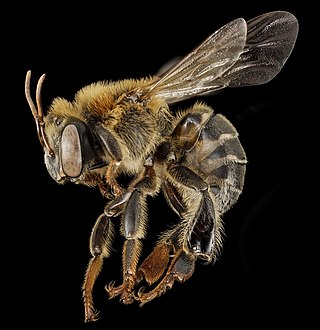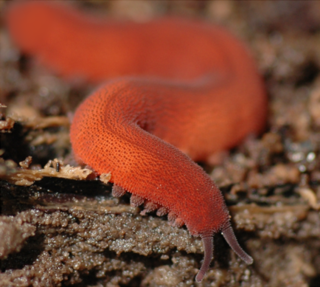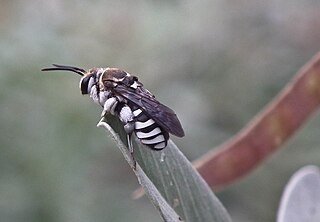
Carpenter bees are species in the genus Xylocopa of the subfamily Xylocopinae. The genus includes some 500 bees in 31 subgenera. The common name "carpenter bee" derives from their nesting behavior; nearly all species burrow into hard plant material such as dead wood or bamboo. The main exceptions are species in the subgenus Proxylocopa, which dig nesting tunnels in suitable soil.

Theodore Dru Alison Cockerell (1866–1948) was an entomologist and systematic biologist who published nearly 4,000 papers, some of them only a few lines long. Cockerell's speciality was the insect order Hymenoptera, an area of study where he described specimens from the United States, the West Indies, Honduras, the Philippines, Africa, and Asia. Cockerell named at least 5,500 species and varieties of bees and almost 150 genera and subgenera, representing over a quarter of all species of bees known during his lifetime. In addition to his extensive studies of bees, he published papers on scale insects, slugs, moths, fish scales, fungi, roses and other flowers, mollusks, and a wide variety of other plants and animals.

Plebeia is a genus of mostly small-bodied stingless bees, formerly included in the genus Trigona. Most of the ~45 species are placed in the subgenus (Plebeia) (s.s.), but there also are four species in the subgenus (Scaura). They differ in only minor structural details, primarily of the hind leg, from other genera that were formerly treated as constituents of Trigona. In some classifications, the genus Schwarziana is treated as a subgenus within Plebeia, but recent morphological analyses indicate that Schwarziana is a distinct lineage, while Plebeia is paraphyletic.

Melitta is a genus of bees in the family Melittidae. It includes about 40 species restricted to Africa and the northern temperate zone. Most of the species are Palaearctic, though three rare species occur in North America.

The cosmopolitan bee genus Ceratina, often referred to as small carpenter bees, is the sole lineage of the tribe Ceratinini, and is not closely related to the more familiar carpenter bees. The genus presently contains over 300 species in 23 subgenera. They make nests in dead wood, stems, or pith, and while many are solitary, a number are subsocial, with mothers caring for their larvae, and in a few cases where multiple females are found in a single nest, daughters or sisters may form very small, weakly eusocial colonies. One species is unique for having both social and asocial populations, Ceratina australensis, which exhibits all of the pre-adaptations for successful group living. This species is socially polymorphic with both solitary and social nests collected in sympatry. Social colonies in that species consist of two foundresses, one contributing both foraging and reproductive effort and the second which remains at the nest as a passive guard. Cooperative nesting provides no overt reproductive benefits over solitary nesting in this population, although brood survival tends to be greater in social colonies. Maternal longevity, subsociality and bivoltine nesting phenology in this species favour colony formation, while dispersal habits and offspring longevity may inhibit more frequent social nesting in this and other ceratinines.

Melipona is a genus of stingless bees, widespread in warm areas of the Neotropics, from Sinaloa and Tamaulipas (México) to Tucumán and Misiones (Argentina). About 70 species are known. The largest producer of honey from Melipona bees in Mexico is in the state of Yucatán where bees are studied at an interactive park called "Bee Planet" which is within the Cuxtal Ecological Reserve.

The Richardiidae are a family of Diptera in the superfamily Tephritoidea.

Thyreus is an Old World genus of bees, one of many that are commonly known as cuckoo bees, or cloak-and-dagger bees, and are kleptoparasites of other species of bees, mostly in the genus Amegilla. They all have strongly contrasting patterns of coloration – three species from the Sydney region, Thyreus nitidulus, T. lugubris, and T. caeruleopunctatus are bright blue and black.

Epiperipatus is the most diverse genus of neotropical velvet worms in the family Peripatidae. Species in this genus are found in Central and South America. Velvet worms in this genus can have as few as 23 pairs of legs or as many as 39 leg pairs. This genus is viviparous, with mothers supplying nourishment to their embryos through a placenta.

Palaeovespa is an extinct genus of wasp in the Vespidae subfamily Vespinae. The genus currently contains eight species: five from the Priabonian stage Florissant Formation in Colorado, United States, two from the middle Eocene Baltic amber deposits of Europe, and one species from the late Paleocene of France.

Wilmatte Porter Cockerell was an American entomologist and high school biology teacher who discovered and collected a large number of insect specimens and other organisms. She participated in numerous research and collecting field trips including the Cockerell-Mackie-Ogilvie expedition. She wrote several scientific articles in her own right, co-authored more with her husband, Theodore Dru Alison Cockerell, and assisted him with his prolific scientific output. She discovered and cultivated red sunflowers, eventually selling the seeds to commercial seed companies. Her husband and her entomological colleagues named a number of taxa in her honor.

Epeolus is a genus of cuckoo bees in the family Apidae. They are often known as variegated cuckoo-bees.

Sphecodes is a genus of cuckoo bees from the family Halictidae, the majority of which are black and red in colour and are colloquially known as blood bees. Sphecodes bees are kleptoparasitic on other bees, especially bees in the genera Lasioglossum, Halictus and Andrena. The adults consume nectar, but because they use other bees' provisions to feed their offspring they do not collect pollen.

Augochlorini is a tribe of sweat bees in the subfamily Halictinae. They are found in the Nearctic and Neotropic realms. They typically display metallic coloration, with many species that are red, gold, green, blue, or purple.

Asphondylia is a cosmopolitan genus of gall midges in the family Cecidomyiidae. All species in this genus induce galls on plants, especially on flowers and flower buds. There are over 300 described species in Asphondylia, with many more likely to be discovered and described, especially in the southern hemisphere.

Anthidiellum is a genus of rotund resin bees in the family Megachilidae. There are more than 60 described species in Anthidiellum.

Tetragona is a genus of bees belonging to the family Apidae.

Pseudapis is a genus of bees belonging to the family Halictidae.
Pasites is a genus of cuckoo bees belonging to the family Apidae.

Oxytrigona is a genus of bees belonging to the family Apidae.


















